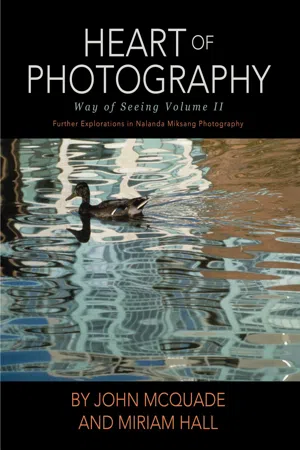
eBook - ePub
Heart of Photography
Further Explorations in Nalanda Miksang Photography
- English
- ePUB (mobile friendly)
- Available on iOS & Android
eBook - ePub
About this book
Heart of Photography by John McQuade and Miriam Hall continues the practice of Nalanda Miksang Contemplative Photography from the first volume, Looking and Seeing. In this volume, we enter together into the deep heart teachings of the fields of perception, with topics like Ordinary/Personal World and People and Other Sentient Beings, and more. In the fields of perception, it is natural to connect deeply with our ordinary lives, only to find therein lies profound ordinary magic. Even if you haven’t read the first volume, Heart of Photography is a powerful entry into the world of contemplative photography.
Frequently asked questions
Yes, you can cancel anytime from the Subscription tab in your account settings on the Perlego website. Your subscription will stay active until the end of your current billing period. Learn how to cancel your subscription.
At the moment all of our mobile-responsive ePub books are available to download via the app. Most of our PDFs are also available to download and we're working on making the final remaining ones downloadable now. Learn more here.
Perlego offers two plans: Essential and Complete
- Essential is ideal for learners and professionals who enjoy exploring a wide range of subjects. Access the Essential Library with 800,000+ trusted titles and best-sellers across business, personal growth, and the humanities. Includes unlimited reading time and Standard Read Aloud voice.
- Complete: Perfect for advanced learners and researchers needing full, unrestricted access. Unlock 1.4M+ books across hundreds of subjects, including academic and specialized titles. The Complete Plan also includes advanced features like Premium Read Aloud and Research Assistant.
We are an online textbook subscription service, where you can get access to an entire online library for less than the price of a single book per month. With over 1 million books across 1000+ topics, we’ve got you covered! Learn more here.
Look out for the read-aloud symbol on your next book to see if you can listen to it. The read-aloud tool reads text aloud for you, highlighting the text as it is being read. You can pause it, speed it up and slow it down. Learn more here.
Yes! You can use the Perlego app on both iOS or Android devices to read anytime, anywhere — even offline. Perfect for commutes or when you’re on the go.
Please note we cannot support devices running on iOS 13 and Android 7 or earlier. Learn more about using the app.
Please note we cannot support devices running on iOS 13 and Android 7 or earlier. Learn more about using the app.
Yes, you can access Heart of Photography by John McQuade,Miriam Hall in PDF and/or ePUB format, as well as other popular books in Art & Photography. We have over one million books available in our catalogue for you to explore.
Information
PART ONE:
HEART OF THE HEART

Resonance And Relationship
Contemplative view provides ground and overview. But contemplative photography is focused on practice, which combines experience and insight. Before we take on the contemplative photography assignments, let’s look at experience. By experience we mean the sensibility of experience, which is the feeling of something beyond what we can get while being fully present with an immediate experience. It is an understanding of interconnectedness we have immediately and deeply in any situation, but which can be hard to articulate because it is both precise and vast at the same time.
A common analogy in Zen is to talk about the finger pointing to the moon—the idea that even to discuss it cannot quite capture being fully present. But images can communicate some of this energy. Something about a drop of water at the tip of a fern after a rainstorm is delicate beyond the fact. The simple moment of seeing a wizened old Chinese grandmother hold hands with her small and sweet-faced granddaughter signifies way beyond the fact. Seeing the sunlit red highlights in your daughter’s dark hair that show both her Irish and Chinese heritage is a heart moment beyond the fact.
In an absolute sense, this heartbeat of the phenomenal world is what we call resonance. We often experience it in our lives on a more relative level through relationship. This is the shift from visual to vision, which is the shift to Level Two. In Level Two, in the heart of photography, we are touched by being in touch. We relate to deeper resonance through relationship. This is what it is to be a contemplative, which is not different from simply being human.
In fact, the most obvious assignment in Level Two for seeing the resonance of relationship is in People and Other Sentient Beings. We are used to both having and acknowledging relationships with other beings. We will explore the energy of these explicit relationships more in that assignment.
However, a relationship, and the resonance inherent to relationship, can happen between a flower and a rock, between a dry riverbed and an acacia bush, between a hammock and a table. Flashes of perception in Level Two often turn out to be about two dots relating to each other in the space, making a complete dot of their relationship.
The subject of Nalanda Miksang photographs is never the topic. In other words, when someone asks Miriam what kind of photography she shoots, they mean subjects—landscape, portraits, etc. But the subject here, even with assignments oriented around more identifiable things in Level Two, is always this resonance, always the relationship at play, always the connection between, which is, in fact, not a connection but the actual co-emergence of the Miksang photographer and the situation itself.
Resonance is a momentary experience in which you feel directly, and to a great depth, how meaningful your life and all of life is; the sense that beyond ongoing life circumstances, there must be more within all this going on. In this resonance we sense that there is a beyond that is not somewhere else. We feel a connection to something inexpressible in what is expressed. We know our life is meaningful, but we may not know exactly how to express this. But we want to.
Nalanda Miksang Level Two images embody the resonance of this heartfelt expression. They are heart images. By this we do not mean sappy or sentimental but deeply resonating heart feeling. While the topic most relating to resonance through relationship is People and Other Sentient Beings, there’s also an affinity between Nalanda Miksang and another traditional contemplative art, one which deeply expresses the more felt and sometimes invisible resonance we have with all of life, including rocks, water, and airplanes. That other art form is Haiku.

Haiku And Resonance
The art that is closest to the practice of contemplative photography is haiku. Haiku is a contemplative literary and poetic form that provides a written equivalent of a clear or true perception.
Traditionally, the pedagogical form for this practice is seventeen syllables in a five/seven/five sequence. Haiku should also include a reference to the season and nature. It is a wonderful example of the precision of resonance because it presents what seemingly cannot be said in only seventeen syllables.
The source of what we think of as haiku today is Basho. Basho was an eleventh-century Japanese haiku master who shifted haiku from a literary practice to a contemplative practice. Basho wrote what is not only one of the best known haiku but also the most decisive haiku. “Old Pond” is the haiku of haikus: the haiku that embodies the way of haiku. Translations into English of “Old Pond” are plentiful. In fact, there is a book called One Hundred Frogs that collects one hundred English translations.
From this collection, let’s consider two:
Old Pond/ A frog jumps in/ the sound of water
An Ancient Pond/ a frog jumps in/ a deep resonance
The first translation is stronger; it leaves open the possibilities of resonance. In general, the contemplative approach is to leave some space or openness. Ironically, although the first translation is more direct and sense oriented, its lack of interpretation is part of its power. The second translation is too conceptual. It is trying to make its point, whereas true haiku only points to the point. However, for teaching purposes, the second translation is informative, particularly the lines “Ancient Pond” and “a deep resonance.”
What is the difference between “the Old Pond” and “An Ancient Pond”? The Old Pond is primordial, a time before time; and fathomless, a depth that can never be plumbed. It is vast, an expanse that can never be found; and inexhaustible, a richness that can never run out.
On the other hand, An Ancient Pond resonates with the Old Pond. It is the resonance itself. This is the shift from primordial to aboriginal. It is the shift from universe to human sentience. It is the shift from the expressible to the inexpressible, through and within the expressible. It is the contemplative.
In the contemplative traditions there is an orientation toward the ancients, those who brought forth birthright human wisdom and practices. We refer to them as perception warriors. In this text, we will contemplate some of the perception warriors who are resources for Nalanda Miksang. As Soetsu Yanagi notes in The Unknown Craftsman, “They saw; before all else, they saw. They were able to see. Ancient mysteries flew from this well-spring of seeing.”
In the Shambhala tradition, we also honor those who bring forth the primordial understanding of basic goodness into the expression of the enlightened society. This is the ancient pond. Now let’s explore resonance.
Consider the way the haiku is structured and how this contemplative expression manifests. Just how old is that pond? Timeless. How deep is that pond? Fathomless. This timeless fathomlessness is our ground, our basic space, the source of clear perception. Within that ground, that space, something happens. A frog jumps in. That is the specific of this haiku, but we get the point behind the point: first nothing is happening, a rich open space, then something happens. In Nalanda Miksang, we call this happening the flash of perception.
Then comes “a deep resonance.” There are many direct and also subtle points here. A subtle point is that this is both simultaneous and in some sense retrospective. The resonance is not completely different or separated from the event of the “jumps in”—there is a simultaneous time event: a happening. Also, the resonance is deep. Again: how deep is that pond?
For a direct point, let’s look at the structure of the pond. The play of surface is simultaneously the play of surface and depth: the surface of a depth and the depth of a surface. This is the structure of resonance and the possibility of appreciation: the simultaneous play of the ordinary and the profound.
The resonance is a happening that is also a trace. As it happens, it simultaneously disappears. The ripples spread out across the surface, and they simultaneously dissolve back into the surface—the surface of the depth. The sound punctuates the space of silence as it returns to silence. It simultaneously appears and disappears.
This is a trace of happening as a happening. It is a traceless trace. As Zen Master Dogen put it: “It is a traceless trace that goes on forever.” This haiku hints that the whole of our phenomenal world—our experience—is a traceless trace that goes on forever. If it is traceless, how do we know it happens? Through expression, through experience. Through trusting life. Through feeling resonance.
Resonance is the way of this traceless trace, a happening that pierces the deep play, which is both the surface of a depth and a depth of a surface. Resonance is always the resonance of resonance. Resonance expresses a beyond that is not somewhere else. Resonance records expressions of the inexpressible. We cannot quite grasp or express experience—it is a slip-slide tip of the tongue—but in our heart of hearts, we experience what we experience and we know what we know.
Resonance is simply a way of saying what we know in our heart of hearts: there is more to life than the same old, same old; that our life matters and that life is an opening. Our life matters in ways we cannot quite grasp or sum up in so many words. If we cannot quite grasp it, there are ways with expression. There are many ways of expression. Just a touch is an expression. Just a look is an expression.
Nalanda Miksang is a photographic way to express deep resonance.
When we tune into resonance, we truly tune in. We realize that we are always already tuned in. We are always already in tune. We are in harmony. We are resonating. Being in tune, we can express in a harmonious way, a peaceful way. When we are in tune, we make contemplative images that are harmonious and peaceful.

The Ordinary Magic Of Nowness
The Shambhala way of ordinary magic is more direct and pragmatic than the Chinese and Japanese contemplative aesthetic. It is more an on-the-spot enlightenment: we simply connect with ordinary magic and trust it. Here, magic is not some special power of transforming things into other things, like lead into gold. Instead, magic is seeing that the world is always already gold. The phenomenal world, our lived experience, is rich, vibrant, and intrinsically beautiful. We simply need to connect with that on the spot, which is easily said and often not so easily done. But it is, in fact, there, regardless of how much we struggle with it.
This points to a deep view of the phenomenal world. The key to both the view and practice of ordinary magic is nowness. Nalanda Miksang uses the exercises of Synchronization and the Flash of Perception to pop us into already existing nowness.
It is important to not confuse nowness with immediacy, the immediate content of the current circumstance. We especially need to not reduce nowness to something that can be measured, like clock time. This is delicate and subtle, because we only connect with nowness through current circumstances. Nowness is a constant newness; the only now is now. Nowness is the suspension of time within time. Nowness is the timeless moment. We could contemplate nowness the same way we did “Old Pond.” Nowness is also a depth and dimension beyond measure. Simultaneously, this now is none other than right now. To support our contemplation, we can look to Chögyam Trungpa’s presentation of nowness in Shambhala, Sacred Path of the Warrior:
To rediscover nowness you have to look back, back to where you came from, back to the original state . . . it is looking back into your own mind, to before history began, before thinking began, before thought ever occurred. When you connect with this original ground then you are never confused by the illusions of past and future. You are able to rest continuously in nowness.
Immediate thought and all of human history are not the issue of newness. On the contrary, they issue from nowness. Nowness is an original state, before thinking began, the original ground. In the Nalanda Miksang teachings, we present this original mind state in two ways: 1) the intrinsic resource of clear seeing, and 2) the space before the flash of perception.
First of all, what Nalanda Miksang calls the intrinsic resource of clear seeing is what Shambhala calls basic goodness. Like basic goodness, Nalanda Miksang holds that clear seeing is our birthright, so all Nalanda Miksang practice and expression draw on that capacity.
At a more relative and practical level, this teaching of nowness helps us work with the momentum of our ongoing situations and states of mind. This nowness state is before and beyond our history and thoughts. It is before and beyond our storylines, interpretations, discursive thinking, past and future; our opinions of what is beautiful or not beautiful, what is worth seeing and not worth seeing, what makes a great photographic image, and so forth. Nowness is both before and beyond the views and practices of conventional photography. Even creative and innovative approaches that break conventional rules are still ruled by the notion that there are rules. Nowness is before and beyond rules.
Nowness is before and beyond all of this, yet not somewhere else. It is a clear and free space from which we make images. Those images embody an aesthetic that is free, clear, simple, direct, and resonant. Here we see directly that Nalanda Miksang practice is a practice of nowness, with Shambhala views and principles. We find the depth of reality in nowness (what is before and beyond) through the now moment (what is happening in this present moment).
As we explore the idea of beyond, we encounter a depth that sustains resonance. This is the spontaneous space of causes and conditions. Chögyam Trungpa frequently used mirrors and reflections to describe this resonance in Shambhala, Sacred Path of the Warrior:
This original state of being can be likened to a primordial or cosmic mirror. By primordi...
Table of contents
- Cover
- Title
- Copyright
- Table Of Contents
- Dedication
- The Heart of Contemplative Photography: An Introduction
- Part One: Heart of the Heart
- Part Two: Impressionism
- Part Three: Ordinary/Personal World
- Part Four: Flowers and Weeds
- Part Five: Zen Aesthetics, Visual Haiku, Drala
- Part Six: Metropolitan Beauty, and Found Calligraphy
- Part Seven: People and Other Sentient Beings
- Masters of Contemplative Photography on the Human Form
- Contemplative People Photography: Other Ways In
- Conclusion
- Appendix
- Glossary
- Study Guide
- Find Us Online
- About the Authors